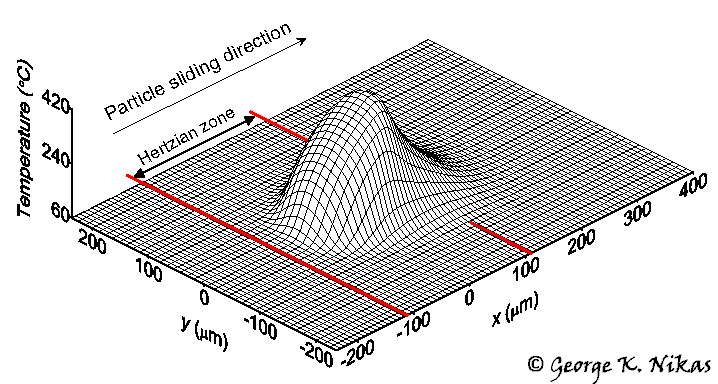
Paper: Effects of debris particles in sliding/rolling EHD contacts.
Authors: Nikas, G. K., Sayles, R. S., Ioannides, E.
Published in: Abstracts of papers of the First World Tribology Congress, 8-12 September 1997, London, England, p. 271.
Download a PDF copy of the abstract (2.4 MB)
Abstract
The influence of debris particles in concentrated contacts has been studied in the past, mainly experimentally. Most theoretical studies were focused on purely rolling, isothermal contacts. The present work is a summary of the theoretical work done in the frame of a research project dealing with the thermo-elastoplastic effects of relatively soft particles in EHD contacts. The theoretical formulation is based on the theory of thermoelasticity and covers several areas of study. The mathematical modelling and computer simulation involve the following.
The motion and deformation of soft debris particles in the inlet and Hertz zone of line EHD contacts for fixed boundary conditions (friction and lubricant flow related).
The three-dimensional thermoelastic distortion of the counterfaces surrounding debris particles and the construction of a wear map showing safe and unsafe regions of operation of the contact. More specifically, the three-dimensional thermoelastic stress-strain-displacement fields due to the presence of a debris particle in the contact are computed at every position during the passage of the particle through the EHD gap. The damage effects of the particle are clearly demonstrated through three-dimensional diagrams of flash temperatures, elastic and thermal stresses-strains-displacements around the contact.
The motion and accumulation of particles in the inlet zone of point EHD contacts. The analysis is based on three-dimensional solution of the steady-state Navier-Stokes equations for viscous flow. Debris particles are randomly put in the fluid flow in front of a ball rolling-sliding on a flat surface and their trajectories in the fluid are computed. The study reveals the behaviour of each particle in the flow in an attempt to correlate fluid starvation and scuffing with various operational parameters of the contaminated contact.
The present work covers sliding-rolling (and not only purely rolling) contacts, it incorporates a three-dimensional thermal stress analysis, and all three-dimensional calculations are based on as few as possible simplifying assumptions. Material thermal properties are allowed to vary with temperature and thermal anisotropy is incorporated into the theoretical model (assuming orthotropic materials). Realistic boundary conditions are used throughout the analysis.
Some of the most important results are the following:
Ductile debris particles are responsible for high flash temperatures (due to frictional heating) in sliding EHD contacts (Fig. 1). Thermal stresses may often play an important role in the yielding and failure of such contacts. The results show that even small and soft debris particles can be quite destructive. A somehow unknown scuffing like failure mode is revealed.
Particles tend to accumulate in the inlet zone of EHD contacts causing fluid starvation and probably scuffing. The effects of the various operational parameters such as debris size, slide-roll ratio and lubricant film thickness on particle entrainment are thoroughly demonstrated. The correlation with relevant experiments is quite supportive, which means that costly and time consuming experiments can be avoided and be replaced by an effective computer simulation.

Fig. 1. Temperature rise on a surface owing to the frictional heating when a 30 micron particle is trapped in a sliding EHD contact.
See also the author's related paper.